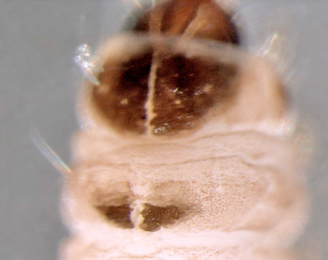|
||||||
|
Coleophora
flavipennella (Duponchel, 1843) Tipped Oak Case-bearer Ornix
flavipennella
Duponchel,
1843. Lep. Fr. Suppl.
4: 338, pl. 78 fig. 6. |
||||||||||||||||||||||||||||||||||||||||||||||||||||||||||||||||||||||||||||||||||||||||||||||
|
Leaf-miner and case-bearer: First case formed of silk, including a small leaf fragment, larva mining leaves. Feeding in spring in a new case on catkins and also mining leaves. Very similar to case of C. lutipennella (British leafminers). Light brown, trivalved, tubular silken case of c. 7 mm with a mouth angle of c. 45°. Immediately after eclosion the larva makes a tiny blotch mine of about 1.7 x 0.7 mm, then excises a leaf case from it. Later this first case is enlarged with silk. No other miner on Oak makes a similar mine, and its presence, in autumn and in combination with full depth mines, is a good indication for flavipennella. The small leaf fragment remains part of the case. In the fully developed case its is to be found mid-dorsally, near the anal end. It is not at all easy to find, as it is withered and discoloured, and may be covered by detritus and newer silk. But if it is seen, it forms the single reliable character to distinguish the case from that of C. lutipennella, living on the same hostplants (Bladmineerders van Europa). Larva: The larvae of moths have a head capsule and chewing mouthparts with opposable mandibles (see video of a gracillarid larva feeding), six thoracic legs and abdominal legs (see examples). The sclerites on the mesothorax are wedge shaped; they are triangular in lutipennella (Bladmineerders van Europa).
Pupa: The pupae of moths have visible head appendages, wings and legs which lie in sheaths (see examples). Distinguishing between the final cases of Coleophora flavipennella and Coleophora lutipennella on Oak (Quercus) is not possible but progress was made by Brian Goodey with their winter cases (Goodey, B., 1992. Ent. Rec. 104: p169-171). His findings were that the winter cases of these two Coleophora spp. could be distinguished by examining the anal end of the case. Coleophora flavipennella has a patch of leaf tissue incorporated into the case, seen as a raised area, whereas in Coleophora lutipennella this raised area does not exist (British leafminers Newsletter). Adult: The adult is illustrated in UKMoths by Nigel Whinney. The species is included in mothdissection.co.uk. Hosts in Great Britain and Ireland:
Hosts elsewhere:
Time of year - larvae: Late September to late October, then April to late May (British leafminers). Time of year - adults: The adults appear in July and August and are attracted to light (UKMoths). Distribution in Great Britain and Ireland: Distributed widely but locally throughout most of Britain (UKMoths) including Bedfordshire, Breconshire, Caernarvonshire, Cambridgeshire, Carmarthenshire, East Cornwall, East Kent, East Norfolk, East Suffolk, Glamorgan, Herefordshire, Hertfordshire, Huntingdonshire, Isle of Wight, Middlesex, North Essex, North Hampshire, North Somerset, North Wiltshire, Shropshire, South Lancashire, South Wiltshire, Stafford, Surrey, West Gloucestershire, West Kent, West Lancashire, West Norfolk, West Suffolk, Westmorland and Worcestershire (NBN Atlas). Also recorded in the Republic of Ireland (UKMoths and National Biodiversity Data Centre Map). Distribution elsewhere: Widespread in continental Europe, including Austria, Belgium, Croatia, Czech Republic, Danish mainland, Estonia, Finland, French mainland, Germany, Hungary, Italian mainland, Latvia, Lithuania, Luxembourg, Macedonia, Norwegian mainland, Poland, Portuguese mainland, Romania, Russia - Central and South, Slovakia, Spanish mainland, Sweden, Switzerland and The Netherlands (Fauna Europaea). NBN Atlas links to known host species:
British and Irish Parasitoids in Britain and elsewhere:
|
||||||||||||||||||||||||||||||||||||||||||||||||||||||||||||||||||||||||||||||||||||||||||||||
| Last updated 11-Jul-2019 Brian Pitkin | ||

